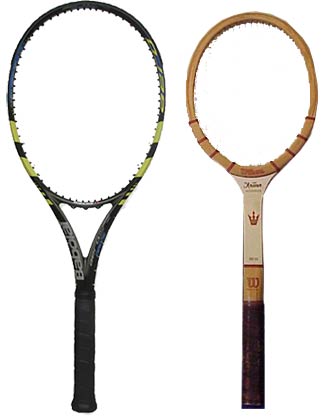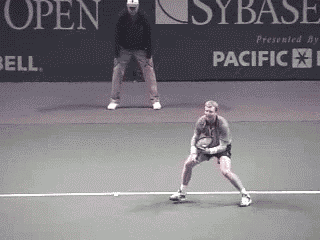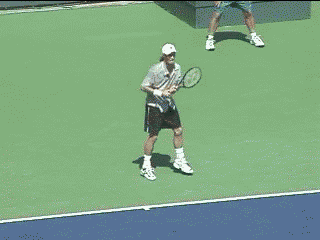|
TennisOne Lessons Tennis in Half a Century or So Philippe Azar
And so you thought, “that's it, tennis has reached its zenith and it just can't and won’t progress.” Well think again, because everything changes….always did, always will. And tennis is no exception. The future will see top players hitting the ball much harder, running even faster, so much so that in half a century, the sport will have little resemblance to what we see now. In 50 years, tennis enthusiasts will probably perceive Rafael Nadal as an unathletic midget who got by on tickling the ball. They'll probably laugh in embarrassment at Agassi's retro outfits and pull jokes at the hairstyles of the spectators and wonder how much an nCoded racquet would be worth on the antique's market. If you don't believe me, take a time machine back to the Wimbledons of the 50's. You'd soon notice that tennis back then was not a sport but an artistic pass-time - something to be classed somewhere between ballet and bowling. For a start, the dress fashion encouraged long pants and a shirt. And no need for great athleticism, no need for daylong training sessions or weight lifting or managers or press conferences. Furthermore, the game was technically much more one-dimensional with most players relying uniquely on the continental grip on all strokes, thereby being limited to flattish or backspinnish groundstrokes. No room for topspin - this was the golden era of smart play, of outwitting your opponent, of placing rather than hitting the ball. The pros played the game as if it were a game of chess. The winner was the tactical master.
Try telling the amateur champions of those days-gone-by that the game in 50 years would be revolutionized into a full time job occupying not only hundreds of professional players but employing thousands more as coaches, tournament organizers, agents, marketers, and that events would be staged in virtually every corner of the world on every kind of surface, every week. Could they have imagined winning millions just for competing in those tournaments and earning millions more from wearing a Nike shirt. Could they have even conceptualized becoming worldwide megastars just because of the way they hit that little yellow fuzz-ball? Racquet technology has done more than anything else to change the nature of the game. And so it was that in the early 80's, with the introduction of lighter and stiffer racquets, players were able to technically refine their games. Rather than dragging half a tree trunk around with them, the new super-light metal frames felt more like a natural extension of the arm. The era of the power play was born and players soon realized that, while backspin was great for control, topspin was superb for power, and a mixture of both therefore held the future of the game.
But it came at a cost: they also soon recognized that to take full advantage of the power that these new racquets materials could offer them, they needed the strength to swing those frames faster than ever, hour after hour, day in day out. It was therefore time to trim up and get fit and strong. All of sudden the game took on a whole new dynamicity. Players were no longer the twiggy artists of the 50's but finely tuned, athletic and sweaty professional fighting machines a-la-Navratilova. It excited the crowds, it excited the media, money poured in and the sport was converted into the industry as we know it now. So, what does the game hold for us over the next 50 years? Well, for a start, players will surely still be attempting to explode racquet frames in anger, but in vain as by then, Wilson will have undoubtedly finally produced the ultimate "unbreakable" frame (and use the future's equivalent of Marat Safin to promote their racquet’s undestructiveness). And even if racquet manufacturers will have the technology to make their racquets ever lighter, professionals will see little advantage in branding these models and will continue to use medium head-heavy frames. Nevertheless, they will be hitting the ball a lot harder and the game will have become one-dimensional once again. All the pros will be using double handed backhands (a product of them taking up the sport at a increasingly younger age) and power will suffocate all technical intricacies, so much so that Federer’s golden backspin backhands or Hewitt's stealthy lobs, or Santoro's deathly drop-shots will be for nostalgics and weekend hackers at the local club. Up to just five years ago or so, combining the three golden components of the game; namely power, placement and consistency; were at best, still a tentative combination where players either won big or lost huge a-la-Philippousis. But recently, the likes of Nadal have demonstrated that the future of the game will definitely see the ball being hit even harder without compromising on placement or consistency.
Today’s player's fall into three categories: baseliners, serve'n'volleyers and all-courters. In the next 50 years, we will witness the elimination of the first two categories and all players fitting into all-round all-court competitors, able to build the point from the baseline and finish it off at the net. They will be more inclined than ever to grab the offensive rather than rely on a defensive counter-punching foundation a-la-Hewitt. Inherent to their increasingly powerful groundstrokes, players will get even more athletic, agile, enduring, and fast. Furthermore, new shots will be invented: volleys will look very different from the open-faced backspins that they are now: players will be able to swat them away and even topspin them from under the net cord with their incredibly fast eye-hand coordination. You can already start to occasionally see that particular trend amongst the doubles specialists. Players will be more inclined than ever to take the ball early, so much so that forehands and backhands will look more like half-volleys with players standing well inside the boundaries of the baseline. And while top players rely on technical, tactical and athletic superiority to overcome their opponents today; tomorrow’s players will call upon the last untouched territory: the mental side of the game. Psychological domination will be the new name of the game. Presently, most pros admit that attaining "The Zone" - a psychological state of mind that transcends into a physical feeling of exuberance, the closest a player will come to playing perfectly - happens randomly and at most in two or three matches a year, and even then it disappears as mysteriously and quickly as it comes. The pros of the future will attain this state as a matter of normality and therefore, along with their coach, stringer, massager, agent, wife and kitchen sink, pros will also hire the services of "mental technicians" in their entourage who's job it will be to psyche them up, aid them in visualizing and winning matches before they are even played, attaining high positive intensities, devising motivational and performance enhancing strategies as well as tactical plans to affect their opponent's concentration and frame of mind.
And the tennis governing bodies will have sharpened up their acts too. With the increased competition from an array of new, wild and exciting sporting events, the ATP, WTA and ITF will see themselves forced into merging in one super association representing the sport as whole. In fact, all tournaments will combine the men's and lady's event, reflecting the mutual benefits and marketing power that this holds. All tournaments will be played on a round robin rather than eliminatory basis, similar to the season-ending ATP finals. The increasing speed of the ball will have forced the downfall of human line judges altogether. But it will be changes to the rules that will probably alter the face of the game more than anything else. The present scoring system, which has seen little change since the invention of tennis, will have succumbed to a major upheaval. Gone will be the days where best-of-three set matches can last anything between 40 minutes and 3 hours, the ultimate nightmare for TV scheduling. A new and revolutionary scoring system will be implemented based on time, just like football or rugby. It will add a new and exciting dimension to the sport where players will be under pressure to play and accumulate as many points as possible within a set time limit. But luckily, some things will never change. The spectators will still be queuing diligently in front of the gates of Wimbledon for their genetically perfected half-dozen strawberries and Pims. The Brits will still be asking themselves where did it all go wrong. Federer's record 15 Grand Slams will have not been surpassed. And maybe, just maybe, I will read this essay in 2057 and laugh at how wrong I was. But never say never. Your comments are welcome. Let us know what you think about Philippe Azar's article by emailing us here at TennisOne.
Philippe Azar is a professional with Peter Burwash International (PBI) and has been teaching tennis internationally for more than 15 years. He is presently based at Tokyo Lawn Tennis Club in Japan. PBI contracts with resorts, hotels and clubs all over the world to direct tennis programs.The company presently has professionals working at 62 facilities in North America, Europe, Asia, Middle East, Caribbean, Pacific and Indian Ocean. During its 30 years in business, PBI tennis professionals have taught tennis to over three million students in more than 135 countries. For more information visit: pbitennis.com |


